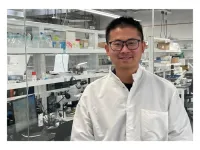(Press-News.org) From a study that analyzed brain images of more than 2,500 people with Parkinson’s disease in 20 different countries, scientists were able to identify patterns of neurodegeneration and create metrics for each of the five clinical stages of the disease.
The work, published in NPJ Parkinson’s Disease, represents a leap forward in the understanding of the disease. The analysis and volume of data obtained in the study could lead to important developments, not only in terms of diagnostic advances but also in terms of enabling new treatments to be tested and monitored as never before.
It is estimated that approximately 4 million people worldwide have Parkinson’s disease. It is a progressive neurological disease that affects certain structures in the brain, especially those related to movement. The progression of the disease is variable and different from patient to patient, and it can take up to 20 years to go through all the stages. In the initial phase, there are the first signs are tremors, muscle stiffness, and slow movements on only one side of the body. The symptoms then become bilateral. In the final stage, the patient is dependent on a wheelchair to get around, as the stiffness in the legs prevents them from walking.
“Clinical diagnosis, supported by some complementary tests, has been well established for many years. However, for the first time, it has been possible to relate the degree of progression of the disease – the five stages of clinical symptoms – to quantitative changes in brain images,” explains Fernando Cendes, senior researcher at the Brazilian Research Institute for Neuroscience and Neurotechnology (BRAINN) – a FAPESP Research, Innovation and Dissemination Center (RIDC), based at the State University of Campinas (UNICAMP), in the state of São Paulo, Brazil.
BRAINN is one of the institutes that make up the Enigma Consortium, an international network that brings together scientists in imaging genomics, neurology, and psychiatry to understand the structure and function of the brain based on high-resolution magnetic resonance imaging, genetic data, and other information from patients with epilepsy, Parkinson’s, Alzheimer’s, autism, schizophrenia, and other neurodegenerative diseases.
Cendes explains that in Parkinson’s disease, there are changes in the brain structure of the so-called basal ganglia – areas of the brain associated with automatic movement. However, the study demonstrated the existence of progressive changes in other cortical areas that had previously been less involved in the disease.
“We observed that as each stage of the disease progressed, there was a greater degree of atrophy or hypertrophy not only in the movement-related structures but also in other cortical areas. And it’s these combinations of atrophy and hypertrophy that are related to the stage of the disease,” he explains.
“But that’s not all we observed, some of these structures also had differences in shape. They had changed their spatial configuration. Some regions of the thalamus [a structure whose function is to relay information from the senses to the cerebral cortex] had become thicker. Other regions, such as the amygdalae [which play a role in regulating social behavior and emotions] had atrophied,” he notes.
The researcher explains that these changes cannot be seen with the naked eye: “They’re submillimetric measurements. However, with programs and the use of artificial intelligence, it’s possible to identify patterns and, in the future, monitor these changes,” he says.
Push for new treatments
By establishing a metric to quantify brain changes associated with the stages of Parkinson’s disease, the study could have several implications. Starting with supporting better diagnosis. “The morphometric data we obtained with this work are sensitive and reproducible measures that allow us to support clinical diagnosis. With the wealth of data we’ve obtained in this study, it’s possible, with the help of artificial intelligence, to create programs that help the clinic,” he says.
Other developments are in the area of treatment. Currently, Parkinson’s disease has no cure, and only the lack of dopamine – a neurotransmitter that the neurons of Parkinson’s patients stop producing, the absence of which triggers all the brain changes and symptoms – is treated.
Over time, however, the disease is not limited to the basal ganglia but also affects other areas of the brain, and patients tend to experience other non-motor symptoms such as depression, anxiety, sleep disturbances, and cognitive changes such as memory loss and eventually dementia.
“The results of this work provide new ways of monitoring treatments that may be developed in the future. The main objective in relation to the disease has been to find a treatment that stops the neurodegenerative process or at least reduces the speed of its progression. And these measures that we’ve identified are essential for evaluating future therapies, to make sure that they’re working in a global way, not only in the brain areas associated with movement but also in the others that suffer changes,” he points out.
A third impact of the study, which analyzed a large amount of data, is not in the field of medicine but in data science. “It’s a very large cohort with different countries, study groups, stages of the disease, and even types of data. So the innovation of the study is not only in identifying these metrics related to the stages of Parkinson’s disease, but also in all the work related to the data. The whole type of analysis used in the work was a major step forward for further studies using artificial intelligence and on other diseases,” says Cendes.
About FAPESP
The São Paulo Research Foundation (FAPESP) is a public institution with the mission of supporting scientific research in all fields of knowledge by awarding scholarships, fellowships and grants to investigators linked with higher education and research institutions in the state of São Paulo, Brazil. FAPESP is aware that the very best research can only be done by working with the best researchers internationally. Therefore, it has established partnerships with funding agencies, higher education, private companies, and research organizations in other countries known for the quality of their research and has been encouraging scientists funded by its grants to further develop their international collaboration.
END
Global study identifies markers for the five clinical stages of Parkinson’s disease
By creating a new metric, researchers envision the possibility of diagnostic and treatment advances for the disease, which is estimated to affect about 4 million people worldwide
2025-02-12
ELSE PRESS RELEASES FROM THIS DATE:
Bacterial cellulose promotes plant tissue regeneration
2025-02-12
Press Release
Information embargoed until February 12, 2025 at 20:00h (time in Spain)
Bacterial cellulose promotes plant tissue regeneration
Researchers have successfully uncovered the molecular mechanisms by which bacterial cellulose patches stimulate the regeneration of plant wounds.
The regeneration process requires the activation of both hormonal and defense response pathways simultaneously.
These cellulose patches offer potential applications in grafting, pruning, and ornamental flower cutting for enhanced plant healing.
Bellaterra (Barcelona), ...
Biohybrid hand gestures with human muscles
2025-02-12
A biohybrid hand which can move objects and do a scissor gesture has been built by a team at the University of Tokyo and Waseda University in Japan. The researchers used thin strings of lab-grown muscle tissue bundled into sushilike rolls to give the fingers enough strength to contract. These multiple muscle tissue actuators (MuMuTAs), created by the researchers, are a major development towards building larger biohybrid limbs. While currently limited to the lab environment, MuMuTAs have the potential to advance future biohybrid prosthetics, aid drug testing on muscle tissue and broaden the potential of biohybrid robotics to mimic real-life forms.
“Rock, paper, ...
Diabetes can drive the evolution of antibiotic resistance
2025-02-12
Antibiotics are powerful, fast-acting medications designed to eradicate bacterial infections. However, in recent years, their dependability has waned as antibiotic resistant bacteria continues to evolve and spread.
Staphylococcus aureus is a leading cause of antibiotic resistance associated infections and deaths. It is also the most prevalent bacterial infection among those with diabetes mellitus, a chronic condition that affects blood sugar control and reduces the body’s ability to fight infections.
Microbiologists Brian Conlon, PhD, and Lance Thurlow, PhD, at the UNC School of Medicine have just shown that people with diabetes are more likely to develop antibiotic-resistant ...
ChatGPT has the potential to improve psychotherapeutic processes
2025-02-12
When it comes to comparing responses written by psychotherapists to those written by ChatGPT,the latter are generally rated higher, according to a study published February 12, 2025, in the open-access journal PLOS Mental Health by H. Dorian Hatch, from The Ohio State University and co-founder of Hatch Data and Mental Health, and colleagues
Whether machines could be therapists is a question that has received increased attention given some of the benefits of working with generative artificial intelligence (AI). Although previous research has found that humans ...
Prioritise vaccine boosters for vulnerable immunocompromised patients and prevent emergence of new COVID variants, say scientists
2025-02-12
Vaccinations alone may not be enough to protect people with compromised immune systems from infection, even if the vaccine has generated the production of antibodies, new research from the University of Cambridge has shown.
The findings, published today in Science Advances, suggest that such individuals will need regular vaccine boosters to protect them and reduce the risk of infections that could be severe and also lead to new ‘variants of concern’ emerging.
Almost 16 million people worldwide are estimated ...
California's most economically and culturally important species among those most vulnerable to projected climate change
2025-02-12
California's most economically and culturally important species among those most vulnerable to projected climate change, per Climate Vulnerability Assessment of 34 marine species.
###
Article URL: https://plos.io/4gslT5s
Article Title: A collaborative climate vulnerability assessment of California marine fishery species
Author Countries: U.S.
Funding: This work was funded by a grant from the Resource Legacy Fund (#15067). Though the funders helped determine the project's initial scope of work, they had no role in data collection and analysis, the decision to publish, or the preparation of the manuscript. END ...
Scientists develop novel self-healing electronic skin for health monitoring
2025-02-12
Los Angeles, CA – February 12, 2025—Researchers have achieved a breakthrough in wearable health technology by developing a novel self-healing electronic skin (E-Skin) that repairs itself in seconds after damage. This could potentially transform the landscape of personal health monitoring.
In a study published in Science Advances, scientists demonstrate an unprecedented advancement in E-Skin technology that recovers over 80% of its functionality within 10 seconds of being damaged – a dramatic improvement over existing technologies that can take minutes or hours to heal.
The technology seamlessly combines ultra-rapid self-healing capabilities, reliable ...
Models show intensifying wildfires in a warming world due to changes in vegetation and humidity; only a minor role for lightning
2025-02-12
Extreme fire seasons in recent years highlight the urgent need to better understand wildfires within the broader context of climate change. Under climate change, many drivers of wildfires are expected to change, such as the amount of carbon stored in vegetation, rainfall, and lightning strikes. Quantifying the relative importance of these processes in recent and future wildfire trends has remained challenging, because previous climate computer model simulations did not capture the full coupling between climate change, lightning, wildfires, smoke and corresponding shifts in solar ...
Unraveling the complex role of climate in dengue dynamics
2025-02-12
The research team led by KIM Jae Kyoung, Professor in the Department of Mathematical Sciences at KAIST and Chief Investigator of the Biomedical Mathematics Group at the Institute for Basic Science (IBS), has unveiled new insights into how weather influences the spread of dengue fever. Their study identifies temperature and rainfall as critical factors driving the global surge in dengue cases and offers actionable strategies for mitigating the disease's impact.
Dengue fever, a mosquito-borne disease, poses an increasingly alarming public health challenge. According to the World Health Organization, reported dengue cases surged from 4.1 ...
INSEAD celebrates five years of impact in North America during its second Americas Conference 2025
2025-02-12
INSEAD, The Business School for the World, celebrated five years of impact of its San Francisco Hub for Business Innovation during its second Americas Conference 2025 on 7-8 February.
Over 250 business leaders, government officials, INSEAD alumni, faculty, and staff convened for insightful and lively conversations centered around the theme: ‘The Future is Now: Bridging Business, Technology, and Humanity’.
The central question driving all the debates was: How can we harness the incredible potential of AI while prioritizing the well-being of humanity. Key themes that emerged included the ability for leaders to see beyond AI hype, a need to embrace disruption, ...
LAST 30 PRESS RELEASES:
Making lighter work of calculating fluid and heat flow
Normalizing blood sugar can halve heart attack risk
Lowering blood sugar cuts heart attack risk in people with prediabetes
Study links genetic variants to risk of blinding eye disease in premature infants
Non-opioid ‘pain sponge’ therapy halts cartilage degeneration and relieves chronic pain
AI can pick up cultural values by mimicking how kids learn
China’s ecological redlines offer fast track to 30 x 30 global conservation goal
Invisible indoor threats: emerging household contaminants and their growing risks to human health
Adding antibody treatment to chemo boosts outcomes for children with rare cancer
Germline pathogenic variants among women without a history of breast cancer
Tanning beds triple melanoma risk, potentially causing broad DNA damage
Unique bond identified as key to viral infection speed
Indoor tanning makes youthful skin much older on a genetic level
Mouse model sheds new light on the causes and potential solutions to human GI problems linked to muscular dystrophy
The Journal of Nuclear Medicine ahead-of-print tip sheet: December 12, 2025
Smarter tools for peering into the microscopic world
Applications open for funding to conduct research in the Kinsey Institute archives
Global measure underestimates the severity of food insecurity
Child survivors of critical illness are missing out on timely follow up care
Risk-based vs annual breast cancer screening / the WISDOM randomized clinical trial
University of Toronto launches Electric Vehicle Innovation Ontario to accelerate advanced EV technologies and build Canada’s innovation advantage
Early relapse predicts poor outcomes in aggressive blood cancer
American College of Lifestyle Medicine applauds two CMS models aligned with lifestyle medicine practice and reimbursement
Clinical trial finds cannabis use not a barrier to quitting nicotine vaping
Supplemental nutrition assistance program policies and food insecurity
Switching immune cells to “night mode” could limit damage after a heart attack, study suggests
URI-based Global RIghts Project report spotlights continued troubling trends in worldwide inhumane treatment
Neutrophils are less aggressive at night, explaining why nighttime heart attacks cause less damage than daytime events
Menopausal hormone therapy may not pose breast cancer risk for women with BRCA mutations
Mobile health tool may improve quality of life for adolescent and young adult breast cancer survivors
[Press-News.org] Global study identifies markers for the five clinical stages of Parkinson’s diseaseBy creating a new metric, researchers envision the possibility of diagnostic and treatment advances for the disease, which is estimated to affect about 4 million people worldwide







